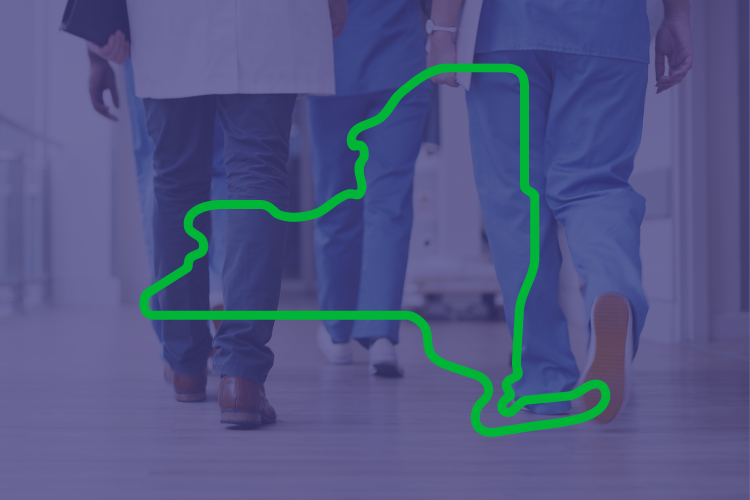There’s a reason Broadway and Wall Street are in New York. Because when New Yorkers do something, they do it well — they go the extra mile. I can tell you from experience that managing medical credentialing services in New York is no different. There are extra forms and extra regulations and everyone operates with extra energy. People might say that I’m a bit intense, so this state is a good match for me.
In this article, I’ll share what I’ve learned about credentialing medical providers in New York.
What’s Unique About Medical Credentialing in New York
Here are some unique things to consider when it comes to New York state medical credentialing requirements.
Many Accredited Organizations
While many other states are focused more on payer credentialing, or the enrollment process, New York organizations are very focused on meeting accreditation requirements. Many organizations I work with need to meet NCQA (National Committee for Quality Assurance) requirements, or requirements for an industry-specific accreditation such as AAAHC (Accreditation Association for Ambulatory Health Care). Since surveyors are likely to perform an unannounced audit to review the provider credentialing files for a random provider document or recredentialing date, having everything stored in MedTrainer’s credentialing platform is really helpful.
Annual Updates
Most of the New York organizations that my team works with ask for NPDB (National Practitioner Data Bank) reports, background checks, malpractice insurance information, and more. And this is information that is completed annually. Like I said, medical credentialing services in New York go the extra mile.
NY Medicaid Requires Snail Mail
More than half of New York payers use portals to submit applications, including Availity which is used by several payers. Many payers also handle recredentialing through CAQH, which simplifies the process. However eMedNY, the New York Medicaid program, asks for a paper application that needs to be sent via postal mail. So be sure to allow time for that process when you are completing medical credentialing services in New York.
Steps to Complete Provider Credentialing in New York
Here are the general steps involved in completing medical credentialing in the state of New York:
- Set Up Online Portals. Ensure the provider’s CAQH profile is up to date and if the provider will be enrolling with Medicare, set up a PECOS portal as well.
- Primary Source Verification. Primary source verification involves contacting original sources — such as educational institutions, licensing boards, and certification bodies — to confirm the authenticity and accuracy of the documents and qualifications provided by the provider. Payers in New York have specific requirements.
- Work History and Reference Checks. To assess the provider’s experience and reputation within the healthcare community, the work history of the provider must be verified without any gaps longer than 30 days.
- Background Checks. Comprehensive background checks help rule out any criminal history, malpractice claims, disciplinary actions, or other records that might send up red flags.
- Payer Enrollment. Providers must be enrolled with every payer they accept insurance from — again, before they start seeing patients. With an average of 5 – 10 payers per provider, this can be a time-consuming and tedious step that needs to start early in the credentialing process.
- Privileging. Privileging involves the collection and review of a provider’s documentation to determine if they meet the minimum criteria to provide the services they’re requesting to provide care to patients within a specific institution. All providers must receive privileges at the facility where they will see patients before they begin practicing.
Tips to Speed Up Credentialing in New York
The time it takes to credential providers in New York can vary depending on a variety of factors. Generally speaking, you should plan for several months at a minimum to complete the credentialing process from start to finish. The exact timeline depends heavily on the provider’s specialty, volume of providers, and the efficiency and completeness of the provider’s documentation.
- Start as soon as the provider is hired. Knowing that medical credentialing in New York can take longer than usual, make sure you start collecting documents as soon as possible. Credentialing early will also alert you to any red flags or complications early in the hiring and onboarding process.
- Make it easy for providers to submit documents. It is much easier for you and the provider to request digital documents as opposed to collecting a paper credentialing packet. Credentialing software offers the ability for providers to securely submit documents to an online portal.
- Set a process specific to New York’s payers. Payers, such as NYSHIP or the Empire Plan, all have specific requirements for the state in which they are located. Understanding this process and creating checklists for each payer will help you to complete medical credentialing in New York much more quickly. A process (workflow) ensures continuity in case the credentialing expert is out of the office or has moved on.
- Set reminders and notifications. Because credentialing in New York could take a while, it is especially important to schedule reminders for follow-ups. There’s likely to be a lot of back-and-forth in verifying information, so be sure to schedule reminders every time there’s an additional step required to complete the action. Credentialing software can automate these reminders to ensure you don’t miss steps or deadlines.
View guide: Secrets to Speed Up Your Credentialing Process With Digital Credentialing
Keep Credentialing Organized for New York Providers
A long process, with some parts online and some on paper, makes medical credentialing in New York a challenge. Using medical credentialing services in New York can help to speed up the process because these credentialing specialists are used to the rules and regulations. In many cases, they have also developed good working relationships with the payers, which can smooth the process.
Find out how MedTrainer can help — whether you just need software or you’re looking for credentialing services to handle the process for you.
